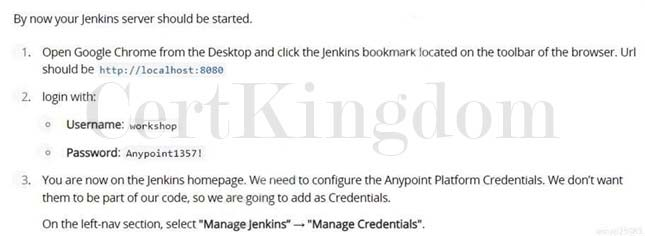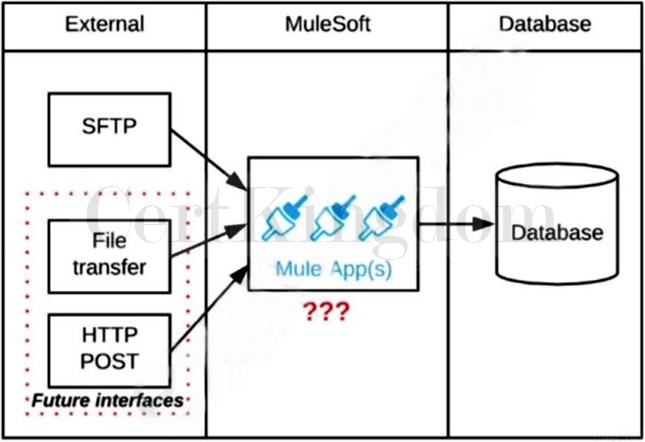Download MuleSoft Certified Integration Architect - Level 1.MCIA-Level-1.CertDumps.2022-09-26.41q.vcex
| Vendor: | Mulesoft |
| Exam Code: | MCIA-Level-1 |
| Exam Name: | MuleSoft Certified Integration Architect - Level 1 |
| Date: | Sep 26, 2022 |
| File Size: | 2 MB |
How to open VCEX files?
Files with VCEX extension can be opened by ProfExam Simulator.
Discount: 20%
Demo Questions
Question 1
An organization is designing an integration solution to replicate financial transaction data from a legacy system into a data warehouse (DWH).
The DWH must contain a daily snapshot of financial transactions, to be delivered as a CSV file. Daily transaction volume exceeds tens of millions of records, with significant spikes in volume during popular shopping periods.
What is the most appropriate integration style for an integration solution that meets the organization's current requirements?
- API-led connectivity
- Batch-triggered ETL
- Event-driven architecture
- Microservice architecture
Correct answer: D
Question 2
A Mule application is being designed to do the following:
Step 1: Read a SalesOrder message from a JMS queue, where each SalesOrder consists of a header and a list of SalesOrderLineltems.
Step 2: Insert the SalesOrder header and each SalesOrderLineItem into different tables in an RDBMS.
Step 3: Insert the SalesOrder header and the sum of the prices of all its SalesOrderLineltems into a table in a different RDBMS.
No SalesOrder message can be lost and the consistency of all SalesOrder-related information in both RDBMSs must be ensured at all times.
What design choice (including choice of transactions) and order of steps addresses these requirements?
- 1. Read the JMS message (NOT in an XA transaction)2. Perform EACH DB insert in a SEPARATE DB transaction3. Acknowledge the JMS message
- 1. Read and acknowledge the JMS message (NOT in an XA transaction)2. In a NEW XA transaction, perform BOTH DB inserts
- 1. Read the JMS message in an XA transaction2. In the SAME XA transaction, perform BOTH DB inserts but do NOT acknowledge the JMS message
- 1. Read the JMS message (NOT in an XA transaction)2. Perform BOTH DB inserts in ONE DB transaction3. Acknowledge the JMS message
Correct answer: C
Question 3
Refer to the exhibit. A shopping cart checkout process consists of a web store backend sending a sequence of API invocations to an Experience API, which in turn invokes a Process API. All API invocations are over HTTPS POST. The Java web store backend executes in a Java EE application server, while all API implementations are Mule applications executing in a customer-hosted Mule runtime.
End-to-end correlation of all HTTP requests and responses belonging to each individual checkout instance is required. This is to be done through a common correlation ID, so that all log entries written by the web store backend, Experience API implementation, and Process API implementation include the same correlation ID for all requests and responses belonging to the same checkout instance.
What is the most efficient way (using the least amount of custom coding or configuration) for the web store backend and the implementations of the Experience API and Process API to participate in end-to-end correlation of the API invocations for each checkout instance?

- The Experience API implementation generates a correlation ID for each incoming HTTP request and passesit to the web store backend in the HTTP response, which includes it in all subsequent API invocations to the Experience APIThe Experience API implementation must be coded to also propagate the correlation ID to the Process API in a suitable HTTP request header

- The web store backend generates a new correlation ID value at the start of checkout and sets it on theXCORRELATION-ID HTTP request header in each API invocation belonging to that checkoutNo special code or configuration is included in the Experience API and Process API implementations to generate and manage the correlation ID

- The web store backend, being a Java EE application, automatically makes use of the thread-local correlationID generated by the Java EE application server and automatically transmits that to the Experience API using HTTP-standard headersNo special code or configuration is included in the web store backend, Experience API, and Process API implementations to generate and manage the correlation ID

- The web store backend sends a correlation ID value in the HTTP request body in the way required by theExperience APIThe Experience API and Process API implementations must be coded to receive the custom correlation ID in the HTTP requests and propagate it in suitable HTTP request headers

Correct answer: B
Question 4
What aspects of a CI/CD pipeline for Mule applications can be automated using MuleSoft-provided Maven plugins?
- Import from API designer, compile, package, unit test, deploy, publish to Anypoint Exchange
- Compile, package, unit test, validate unit test coverage, deploy
- Compile, package, unit test, deploy, integration test
- Compile, package, unit test, deploy, create associated API instances in API Manager
Correct answer: C
Explanation:
Reference: http://workshop.tools.mulesoft.com/modules/module7_lab4#step-2-configure-the-mule-mavenplugin Reference: http://workshop.tools.mulesoft.com/modules/module7_lab4#step-2-configure-the-mule-mavenplugin

Question 5
An integration Mule application is deployed to a customer-hosted multi-node Mule 4 runtime cluster. The Mule application uses a Listener operation of a JMS connector to receive incoming messages from a JMS queue.
How are the messages consumed by the Mule application?
- Regardless of the Listener operation configuration, all messages are consumed by ONLY the primarycluster node
- Depending on the JMS provider's configuration, either all messages are consumed by ONLY the primarycluster node or else ALL messages are consumed by ALL cluster nodes
- Regardless of the Listener operation configuration, all messages are consumed by ALL cluster nodes
- Depending on the Listener operation configuration, either all messages are consumed by ONLY theprimary cluster node or else EACH message is consumed by ANY ONE cluster node
Correct answer: B
Question 6
What operation can be performed through a JMX agent enabled in a Mule application?
- View object store entries
- Replay an unsuccessful message
- Deploy a Mule application
- Set a particular log4j2 log level to TRACE
Correct answer: D
Question 7
Refer to the exhibit. A business process involves the receipt of a file from an external vendor over SFTP. The file needs to be parsed and its content processed, validated, and ultimately persisted to a database. The delivery mechanism is expected to change in the future as more vendors send similar files using other mechanisms such as file transfer or HTTP POST.
What is the most effective way to design for these requirements in order to minimize the impact of future change?

- Use a composite data source so files can be retrieved from various sources and delivered to a MuleSoftBatch Job for processing
- Use a MuleSoft Scatter-Gather and a MuleSoft Batch Job to handle the different files coming from differentsources
- Create a Process API to receive the file and process it using a MuleSoft Batch Job while delegating thedata save process to a System API
- Create an API that receives the file and invokes a Process API with the data contained in the file, then havethe Process API process the data using a MuleSoft Batch Job and other System APIs as needed
Correct answer: D
Question 8
An integration Mule application is being designed to synchronize customer data between two systems. One system is an IBM Mainframe and the other system is a Salesforce Marketing Cloud (CRM) instance. Both systems have been deployed in their typical configurations, and are to be invoked using the native protocols provided by Salesforce and IBM.
What interface technologies are the most straightforward and appropriate to use in this Mule application to interact with these systems, assuming that Anypoint Connectors exist that implement these interface technologies?
- IBM: DB accessCRM: gRPC
- IBM: RESTCRM: REST
- IBM: CICSCRM: SOAP
- IBM: ActiveMQCRM: REST
Correct answer: D
Question 9
An XA transaction is being configured that involves a JMS connector listening for incoming JMS messages.
What is the meaning of the timeout attribute of the XA transaction, and what happens after the timeout expires?
- The time that is allowed to pass without the transaction being ended explicitlyAfter the timeout, the transaction is forcefully rolled-back
- The time that is allowed to pass for stale JMS consumer threads to be destroyedAfter the timeout, a new JMS consumer thread is created
- The time that is allowed to pass between receiving JMS messages on the same JMS connectionAfter the timeout, a new JMS connection is established
- The time that is allowed to pass between committing the transaction and the completion of the Mule flowAfter the timeout, flow processing triggers an error
Correct answer: A
Question 10
An API has been unit tested and is ready for integration testing. The API is governed by a Client ID Enforcement policy in all environments.
What must the testing team do before they can start integration testing the API in the Staging environment?
- They must request access to the Staging environment and obtain the Client ID and Client Secret for thatenvironment to be used for testing the API
- They must request access to the API instance in the Staging environment and obtain a Client ID and ClientSecret to be used for testing the API
- They must be assigned as an API version owner of the API in the Staging environment
- They must access the API portal and create an API notebook using the Client ID and Client Secret suppliedby the API portal in the Staging environment
Correct answer: C
HOW TO OPEN VCE FILES
Use VCE Exam Simulator to open VCE files

HOW TO OPEN VCEX AND EXAM FILES
Use ProfExam Simulator to open VCEX and EXAM files


ProfExam at a 20% markdown
You have the opportunity to purchase ProfExam at a 20% reduced price
Get Now!



